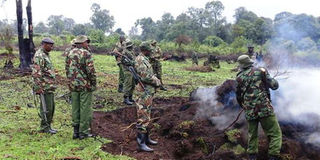KFS set to rehabilitate Mau eco-system

Narok County rangers and KWS officers destroy charcoal kilns after the Narok County Environment Technical committee slapped an indefinite ban on charcoal burning and transportation in efforts to curb depletion of forests in the region. PHOTO | GEORGE SAYAGIE | NATION MEDIA GROUP
What you need to know:
- County Eco-system Conservator Mr James Mburu said his office plans to plant over 2.5 million seedlings in depleted areas of the Mau eco-system before the end of the year.
- A part from destruction caused by the rains, the program will also target the most affected parts of the forest which was destroyed by fires early this year and charcoal burning, which include South Mau block, Nairotie, Olenguruone and Trans-Mara forests.
- The initial forest cover in the county was 87,000 hectares in 2011 which is around 16.66 per cent of the total land size in the county. However, due to destruction, this has now declined to less than 14.6 per cent, according to the official.
The Kenya Forest Service (KFS) has embarked on a program to rehabilitate 50 hectares of the Mau eco-system in Narok County during the ongoing rainy season.
County Eco-system Conservator Mr James Mburu said his office plans to plant over 2.5 million seedlings in depleted areas of the Mau eco-system before the end of the year.
"We expect to plant 50, 000 seedlings in every hectare of depleted forest," he said.
The project will involve mobilising communities through forest associations to plant the trees in a move to motivate them to own the program and take care of the trees.
A part from destruction caused by the rains, the program will also target the most affected parts of the forest which was destroyed by fires early this year and charcoal burning, which include South Mau block, Nairotie, Olenguruone and Trans-Mara forests.
Charcoal burning, considered a booming business in Narok County, has greatly contributed to depletion of the forest cover within the county.
Narok County is identified as the biggest charcoal producer in the country.
Narok produces over 25 million tonnes of charcoal annually, believed to be a major leading cause of the destruction of the Mau complex.
The thriving business has been attributed to corrupt security officials and a few cartels which control the multi- million shillings charcoal business.
Walking along various roads from Mau complex, one will witness hundreds of donkeys, mostly driven by women transporting charcoal towards Narok town where brokers are waiting to buy it at as low as Sh200 per bag and sell it in Nairobi for as much as Sh1,500 per bag; believed to translate into it a multi- million enterprise.
Mr Mburu, speaking during a planning meeting in Narok town, said the most affected forests are Nyakweri in Transmara and Olposimoru forest whose 7,000 hectares had been cleared for agriculture.
"We have seen the negative impacts of forest destruction hence it's the best time to take advantage of this El Niño seasons to plant as many tree seedlings as possible," he said.
The initial forest cover in the county was 87,000 hectares in 2011 which is around 16.66 per cent of the total land size in the county. However, due to destruction, this has now declined to less than 14.6 per cent, according to the official.
Narok County has also experienced a myriad of disasters such as floods, fires and drought which all have contributed to the depletion of Mau water tower.
"We cannot watch as the Mau which is a lifeline to our wildlife and millions of people downstream get destroyed by selfish people who don't have the interest of the country at heart," Mr Mburu said.
He urged the area residents to consider engaging in commercial tree farming where they can buy and plant commercial bamboo and blue gum which mature within three years and five years respectively.
He said the seedlings can be obtained from their offices in Narok town.
He appealed to politicians to stop politicising the Mau forest settlement but instead bring the communities together and sensitise them on the importance of forest conservation.





